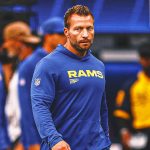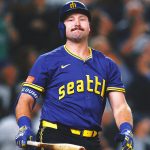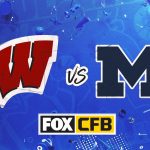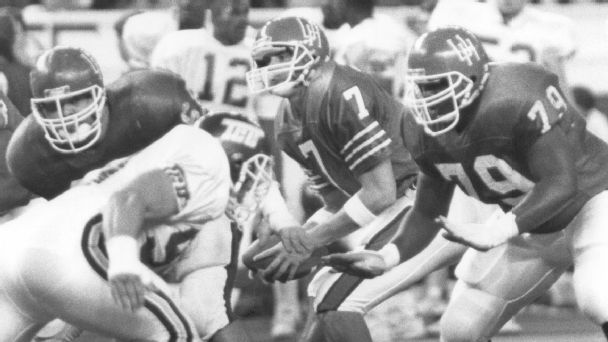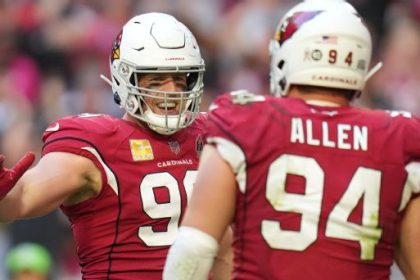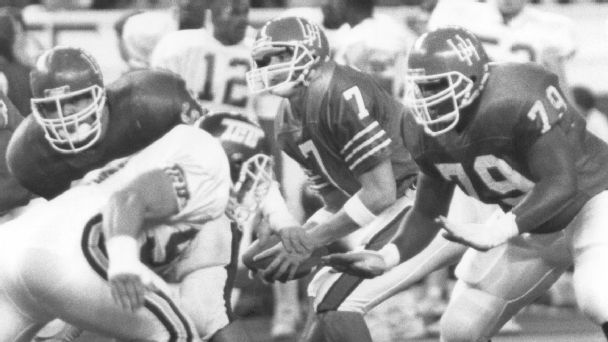
ON NOV. 3, 1990, all hell broke loose in the Astrodome.
The TCU Horned Frogs and Houston Cougars combined to make history, stunning the college football world in a shootout that defied belief, with Houston ultimately prevailing, 56-35. Seven NCAA records were set, including a combined 1,563 yards of offense and the most combined passing yards in a game (1,253). There were 13 touchdown drives, with the longest one clocking in at 1:39. As in 99 seconds.
The game drew just 25,725 fans and aired on tape delay at 12:30 a.m. the next day on a regional network called Home Sports Entertainment. Yet, 33 years later, its legacy will be felt in the Cougars’ first Big 12 game, which reunites Houston and TCU in college football’s highest levels for the first time since the Southwest Conference dissolved after the 1995 season.
The game became national news with highlights across the country showing footballs flying left and right, more akin to a tennis match than a football game in that era. That’s what happens when a backup quarterback making his first start, TCU’s Matt Vogler, throws for 690 yards and his opponent, David Klingler, adds 563 and seven touchdowns.
Sonny Dykes, then a baseball player at Texas Tech, couldn’t believe what he was seeing. Hal Mumme, then the coach at miniscule Iowa Wesleyan, watched TCU coach Jim Wacker’s weekly show to see what he was up to, jealous of the yardage they piled up.
“Maybe we’re not crazy after all,” Mumme told his offensive coordinator, Mike Leach, as they continued trying to light up scoreboards of their own, with a sophomore receiver named Dana Holgorsen catching passes in their newly christened Air Raid scheme.
Dykes said this week the game was one that piqued his interest in coaching football, despite not playing in college. He grew up in the SWC era while his dad, Spike Dykes, was the head coach at Texas Tech. In the 1986 season, Spike’s first year as the Red Raiders’ coach, Houston averaged 96.6 passing yards per game under Bill Yeoman, the pioneer of the famed veer option rushing attack, while Wacker, a veer acolyte himself, and TCU averaged 109.6. Just four years later, this was a seismic shift.
“I had just never seen anything like it before, in particular two Texas teams,” Sonny Dykes said. “I just remember thinking, ‘Man, if this is what the future looks like, I’m pretty excited about it.'”
Dykes went all in. The record for the combined quarterbacks’ yardage stood until 2014, when it was broken by Washington State’s Connor Halliday (734) and Cal’s Jared Goff (527) for a total of 1,261 yards. The two coaches in that one: Leach and Dykes. In 2016, it was broken again by Texas Tech’s Patrick Mahomes (734) and Oklahoma’s Baker Mayfield (545), both with Air Raid playcallers, Kliff Kingsbury and Lincoln Riley, who played when Leach and Dykes were coaching in Lubbock.
Bob DeBesse, TCU’s offensive coordinator in 1990, who’s now the head coach at Grapevine High School in the Dallas-Fort Worth area, says that long-ago game still feels current.
“It was a glimpse into the future,” DeBesse said. “But who would have ever guessed the future would look like it does?”
JOHN JENKINS ALWAYS believed football should look like it does. He’s a cocky, enigmatic, secretive mad scientist of a coach and the architect of Houston’s version of the run ‘n’ shoot. He coached alongside run ‘n’ shoot guru Mouse Davis for the Houston Gamblers of the USFL, then was promoted to replace Davis as offensive coordinator and got to work tweaking the scheme. In his first game as a playcaller, he rallied the Gamblers and quarterback Jim Kelly from a 33-13 deficit with eight minutes left in the game to a 34-33 win that Sports Illustrated called “The Greatest Game Never Seen” because it also wasn’t televised.
By the time he got to UH in 1987, as offensive coordinator for Jack Pardee, the Cougars were in trouble. In Yeoman’s last season in 1986, the Cougars finished 1-11 and were under NCAA investigation, as much of the SWC was in this era. Jenkins said there was even talk of dropping football.
“The Astrodome was no longer an Eighth Wonder of the World; nobody cared anymore and they didn’t want to see that,” Jenkins said. “Jack Pardee asked me to go talk to half a dozen boosters and I told them, ‘Hey, wait a minute, don’t even think about dropping football at this school. You have no idea what’s fixin’ to happen.’ I’d heard them all — [Baylor’s] Grant Teaff and [Texas’] David McWilliams and Spike and everybody, R.C. [Slocum at Texas A&M], all those guys talking piling up bodies for a 2-yard gain. They have no idea what’s fixin’ to hit them. There’s gonna be some nosebleeds up in the upper deck with balls flying through the air.”
By 1989, Jenkins was right. The Cougars scored 53.5 points a game. They averaged 511 passing yards and 625 total yards (both still NCAA records), culminating in a Heisman Trophy for Andre Ware. Manny Hazard caught a record 142 passes. Chuck Weatherspoon averaged a record 9.6 yards per carry. Houston topped the 60-point mark five times that year, including scoring 95 against SMU and rolling up 1,021 yards of offense (also still a record, as you might guess). Again, nobody saw it, because the Cougars were banned from television because they were on a third NCAA probation because of an estimated 250 recruiting violations at the end of the 25-year Yeoman era, according to the NCAA.
Wacker too had realized that to keep up at TCU, he was going to have to ditch the veer. A few years prior, he installed the “triple shoot,” a variation of the run ‘n’ shoot that utilized more tight ends and backs. Before Leach’s Air Raid offense at Texas Tech made Big 12 teams keep pace, Jenkins was already doing it.
This caught the eye of Stephen Shipley, a highly recruited receiver from East Texas. Shipley has his own deep connections to the evolution of football in the state. He’s the uncle of Jordan and Jaxson Shipley, the former Texas Longhorns wide receivers. But in the late 1980s, his high school, Lindale, was throwing the ball more than most Texas schools did, thanks to the talented Shipley and a strong-armed quarterback named Pat Mahomes. As in the former major leaguer and father of the reigning Super Bowl MVP.
“I remember getting calls from OU and A&M and my first response was, ‘Heck no, I’m not coming to block for your running backs,'” Shipley said. “I wanted to catch the ball. That was the main reason I went to TCU. I knew they had the sanctions, limited scholarships, and it was going to be a tough road, but it was a chance to be a part of the change of the game.”
After the 1989 season, Pardee was hired as the coach of the Houston Oilers (where he unleashed the same offensive assault with Warren Moon across town), and Jenkins succeeded him at U of H as head coach. As his own boss, Jenkins could be as brash as he wanted, like when he unleashed Klingler to throw 11 touchdowns against Eastern Washington that season. When Houston and TCU finally met in Nov. 1990, the Southwest Conference, the laboratory that gave us the Wishbone and the Veer, now saw two dueling all-out aerial attacks.
Marc Dove, TCU’s defensive coordinator at the time, had worked for Emory Bellard, the inventor of the wishbone alongside Jenkins — who was his linebackers coach — at Mississippi State, and said the run ‘n’ shoot was much more challenging to defend. So when it came time to face his old friend Jenkins and Klingler, he knew he had his work cut out for him.
“We tried about everything and found not much of anything that worked,” Dove said of devising schemes to beat the run ‘n’ shoot.
When it came time to face Houston in 1990, Dove tried to mix up coverages, but was also aggressive. Klingler threw four interceptions, though Jenkins said some were bobbled passes and weren’t on him. Still, the machine wasn’t up to Jenkins’ standards at times.
“The expectation was perfection, we expected to score on every play. I remember coming off the field after a five-play drive and Jenks would be pissed, saying ‘What are we doing out there? What’s taking us so long to score?'” Klingler said, laughing. “He was just as frustrated as he could be, because we left three or four touchdowns on the field in five plays and he’d had just about enough of watching it.”
Vogler, meanwhile, was under fire the entire game. Jenkins didn’t believe the backup could stand up to the pressure, so he instructed his defensive coordinator, Larry Coyer, to blitz him relentlessly.
“Oh, [Coyer] was nervous as hell,” Jenkins said. “They all are, all those defensive guys. They always worry like hell, they’re going to get burned on a blitz. Hey, in my opinion, we were ready to go and did not think they could hold up and match us score for score.”
But Vogler did. He stood in there and kept throwing it over the top, including an 80-yard touchdown to Cedric Jackson and an 88-yard score to Kyle McPherson in the first half alone. Klingler, meanwhile, threw four touchdowns passes in the first half as Houston took a 28-14 lead.
“I can remember we’re starting to run off the field at halftime and we crossed paths,” Dove said of his friend Jenkins and Coyer, who he also knew well. “I said, ‘You’re gonna get me fired, John!’ He said, ‘Well, that’s the way it goes.’ And then Coyer said, ‘You’re doing better than me!'”
Vogler rallied TCU with a big third quarter, tying the score at 28-28 with a 9-yard TD to Shipley.
“They blitzed more than anybody I’ve ever seen in my life,” Vogler said. “We were shocked, like, ‘Guys, it’s not working. We’re dropping 88-yard bombs on you because you’re blitzing. Keep doing it and we’ll keep doing this and we’ll just see whoever shakes out with the most points.’ That’s pretty much what happened.”
Klingler and Houston, however, rolled from there, including two touchdown passes to Marcus Grant, who was being covered by TCU’s Larry Brown, the future Super Bowl MVP for the Dallas Cowboys. Grant’s final line: 3 catches, 103 yards, 3 touchdowns.
“I don’t remember what the score was,” Dove said, being reminded it was 56-34. “I’m surprised it wasn’t 101-100.”
There was zero reason to expect this result. Vogler had arrived at TCU because Auburn was put on probation and players could transfer. He was looking for a home, but Auburn was on the quarters system and most schools had already begun classes. He knew some coaches at TCU through his family, so he flew in, arrived on the final day of enrollment, and was running the scout team a week later, backing up Leon Clay.
After Clay was injured, Vogler came into the Houston game with no touchdowns and three interceptions on the year. He finished his first start by going 44-of-79 (an NCAA record for attempts) for 690 yards, five touchdowns and two interceptions. The Frogs finished with five 100-yard receivers, each of whom caught a touchdown.
“The stars have got to be aligned to have that many yards passing and that much explosiveness on both sides of the ball,” DeBesse said. “Larry Coyer went on to become a highly successful defensive coordinator in the NFL for years, but when we shook hands at the end of that game, I’ll never forget the bewildered look on his face. All he said was, ‘What the hell just happened?’ I’ll never forget that. I think we all kind of felt a little bit of that.”
KLINGLER COMPLETED 36 of 53 passes for 563 with 7 TDs and 4 interceptions. Hazard caught 13 for 164. Weatherspoon, the 5-foot-7, 230-pound human wrecking ball, had 17 carries for 178 yards and a TD and caught 6 passes for 92 yards and 2 TDs.
“We would throw about 300 passes a day every practice,” Klingler said. “Game day was like a day off. When you look back on that day, and even the day that I threw for 716 yards against Arizona State, I went 40 for 70. I mean, I missed 30 passes. So it was really actually a pretty bad day. But what we did, we did so well that you could miss 30 times and still put up ridiculous numbers.”
Vogler said the Frogs were not prepared for a four-hour game, missed their flight and had to charter a plane home. In addition to those 79 pass attempts, he had 15 of the Frogs’ 21 carries. He said he spent the flight back to Fort Worth lying in the aisle, with an IV in his arm.
“I was cramping, my legs were locking up and I was dehydrated,” Vogler said. “It was an event, man, and I just got home and went straight to bed. I don’t I don’t think most of us woke up until midday the next day.”
Klingler, meanwhile, says he didn’t see the big deal.
“Oh, we would’ve played them in a doubleheader,” he said, laughing.
In a presocial media era, with no television, most of the country found out about the donnybrook the next morning in their local newspapers. Jenkins said that’s when the calls started.
“When Matt registered those kinds of numbers and still got beat by three touchdowns, people started asking, ‘What in the world is going on down there?'” he said.
Dykes said he was always fascinated by Jenkins. Mumme said he started out as a run ‘n’ shoot coach, and has spoken at clinics with Jenkins for decades. But they all agree that nobody knows exactly how Jenkins did it, because his offense is complicated, with receivers automatically converting routes on every play based on coverage, and quarterbacks who have to be in sync. Jenkins was notoriously secretive, rebuffing any attempts to come study what he did, including from Joe Paterno who called to say his quarterbacks kept showing him highlights of Houston and he wanted to know more.
“[Jenkins] was ahead of his time for sure. He was the offensive guru in college football. Not only could nobody figure it out, he didn’t let anybody figure it out,” DeBesse said. “He’s very secretive about what he was doing.”
Klingler agreed.
“You’d have a better chance to get something out of a Russian spy,” Klingler said. “I don’t know that anybody today is doing what he was doing — or has any idea what he was doing. That’s the problem. Me and my brother [Jimmy, who followed him as the Houston starter], Andre [Ware] and Jenks are probably the four guys that know what we were doing, and it’ll probably die with us.”
The Southwest Conference was hobbled by infighting and NCAA punishment, mostly affecting recruiting by any school not named Texas or Texas A&M. After a magical 10-1 season in 1990, with a loss only to Texas, Jenkins suffered through two 4-7 seasons and was forced to resign. Wacker finished 7-4 in 1991, but didn’t make a bowl game. He departed for Minnesota. Both programs suffered in the aftermath. Houston won four games over the next three seasons under Kim Helton. TCU went 13-20-1 in the same span under Pat Sullivan.
A Big 12 matchup marks a new era in the rivalry, with two coaches in Holgorsen and Dykes who are students of games like these.
“When I was a sophomore and junior in college I actually went to several clinics to hear John speak and take notes,” Dykes said. “John had his way, his belief of doing things and that had a huge impact on the Air Raid. The shovel passes and the screens that run ‘n’ shoot teams threw were a big part of the early Air Raid scheme. Football is all about six degrees of separation and there’s piles of influence everywhere. All of our philosophies got shaped by people and events that we didn’t really even know would have an impact on the way we think and what we do as a result.”
The 1990 game, a split-second in the grand scheme of football’s history, made a lasting impression. On Saturday night, the Cougs and Frogs will be pitching it around again in a game that means something.
“Houston finally gets to compete with major college competition again, and they open up with TCU to start with,” Jenkins said. “How about that? What a joy to see that again.”

